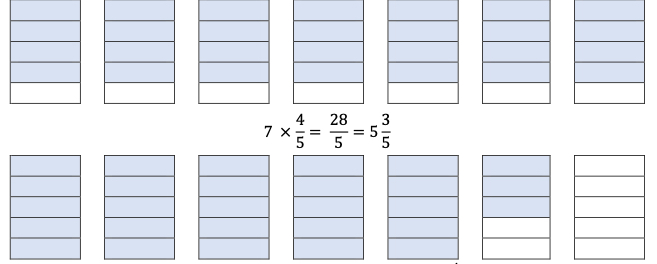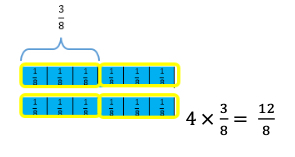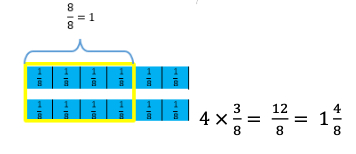General Information
Benchmark Instructional Guide
Connecting Benchmarks/Horizontal Alignment
Terms from the K-12 Glossary
- NA
Vertical Alignment
Previous Benchmarks
Next Benchmarks
Purpose and Instructional Strategies
The purpose of this benchmark is for students to examine how numbers change when multiplying by fractions (MTR.2.1). Students already had experience with this idea when they multiplied a fraction by a whole number in grade 4 (MA.4.FR.2.4). Work from this benchmark will help prepare students to multiply and divide fractions and decimals with procedural fluency in grade 6 (MA.6.NSO.2.2).- It is important for students to have experiences examining:
- when multiplying by a fraction greater than 1, the number increases;
- when multiplying by a fraction equal to 1, the number stays the same; and
- when multiplying by a fraction less the 1, the number decreases.
- Throughout instruction, encourage students to use models or drawings to assist them with a visual of the relative size. Models to consider when multiplying fractions to assist with finding relative size without calculating include, but are not limited to, area models (rectangles), linear models (fraction strips/bars and number lines) and set models (counters). Include examples with equivalent fractions and decimals (MTR.2.1).
- Have students explain how they used the model or drawing to arrive at the solution and justify reasonableness of their answers (MTR.4.1).
Common Misconceptions or Errors
- Students may believe that multiplication always results in a larger number. This is why it is imperative to include models during instruction when multiplying fractions so students can see and experience the results and begin to make generalizations that are based on their understanding. Ultimately, allowing students to begin to understand that multiplying by a fraction less than one will result in a lesser product, but when multiplying by a fraction greater than one will result in a greater product.
Strategies to Support Tiered Instruction
- Instruction includes opportunities to predict and explain the relative size of the product of a given number by a fraction less than one or a fraction greater than one. Students use models to check their prediction and solve. The teacher guides students to connect that multiplying a given number by a fraction less than one will result in a smaller number and that multiplying a given number by a fraction greater than one will result in a larger number.

- For example, the teacher displays the problem 7 x and asks students to predict if the product will be greater than, equal to, or less than 7 (it will be less than 7). Students use a visual model to represent the problem to determine 7 × = . This is repeated with additional examples using fractions both greater than, equal to, and less than one.
- Instruction includes providing hands-on opportunities to predict and explain the relative
size of the product of a given number by a fraction less than one or a fraction greater than one. Students use fraction strips/bars or counters to check their prediction and solve, connecting that multiplying a given number by a fraction less than one will result in a smaller number and that multiplying a given number by a fraction greater than one will result in a larger number.
- For example, the teacher displays the problem 4 × = ___. Then, the teacher asks
students to predict if the product will be greater than, equal to, or less than 4 (it will be less than 4).
- Using fraction bars or fraction strips, the teacher models solving this problem with explicit instruction and guided questioning. Students explain how to use fraction bars or fraction strips as a model to solve this problem. This is repeated with additional examples using fractions both greater than, equal to, and less than one.
- For example, the teacher displays the problem 4 × = ___. Then, the teacher asks
students to predict if the product will be greater than, equal to, or less than 4 (it will be less than 4).


Instructional Tasks
Instructional Task 1
Derrick is playing a computer game where he must multiply a number by a factor that increases the number’s size each time. Select all of the factors that he could multiply by to continue to increase the size of his number? Explain your thinking.- a.
- b.
- c. 1
- d. 1.01
- e.
- f.
- g.
- h.
Instructional Items
Instructional Item 1
Which of the following expressions will have a product greater than 4?- a. 4×
- b. ×4
- c. 4×
- d. ×4
Instructional Item 2
- Fill in the blank. The product of the expression × 20 will be _____________ 20.
- a. less than
- b. equal to
- c. greater than
- d. half of
*The strategies, tasks and items included in the B1G-M are examples and should not be considered comprehensive.
